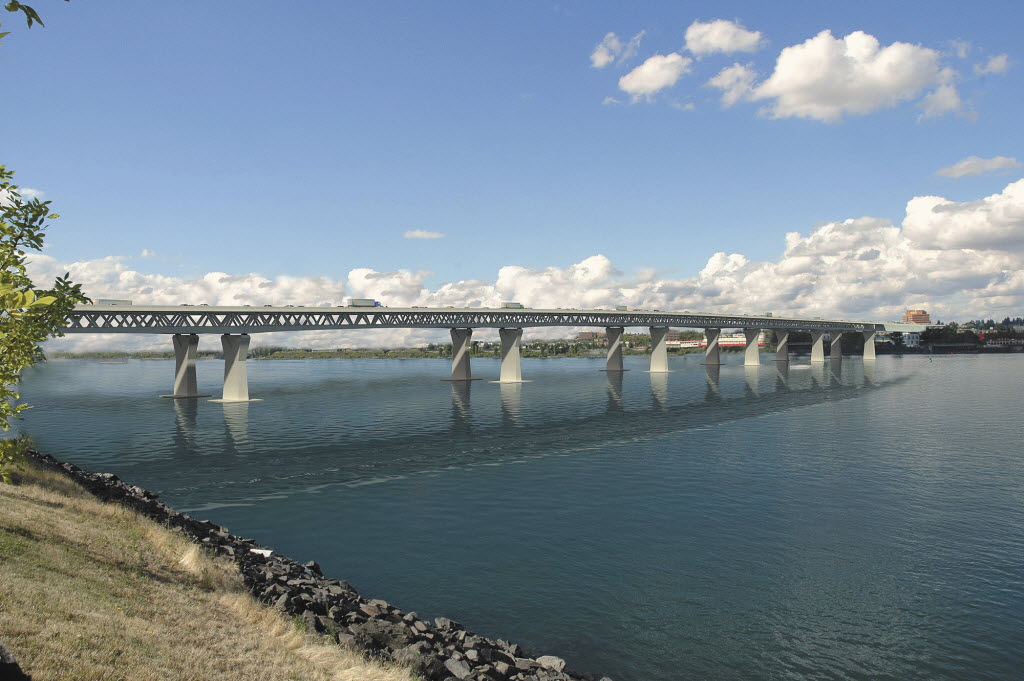With an 18-11 vote on Monday, the Oregon Senate moved funding the Columbia River Crossing off the state’s legislative agenda this year.
It also moved the spotlight to this side of the Columbia River.
“All eyes now kind of focus on Olympia, and what the state of Washington is going to do,” said state Rep. Jim Moeller, D-Vancouver.
The Oregon Senate vote — and Gov. John Kitzhaber’s expected signature — authorizes borrowing $450 million to pay Oregon’s share of the proposed Interstate 5 Bridge replacement. The plan easily cleared the Oregon House last week. But the bill also attached several conditions to that money, among them that Washington must pony up a state share of its own. The CRC must also secure crucial federal funding and a bridge permit from the U.S. Coast Guard to move forward. None of those things have happened yet.
Moeller, a strong backer of the CRC, called Oregon’s action “great news.” But the controversial project may face a tougher fight in the Washington Legislature, where any funding commitment would have to get by a Republican-controlled Senate. Oregon’s seemingly swift approval doesn’t change the project’s shortcomings, said Sen. Ann Rivers, R-La Center.
“I don’t think it makes a difference,” Rivers said. “The concerns remain strong up here.”
In addition to replacing the I-5 Bridge, the $3.4 billion CRC would extend light rail into Vancouver and rebuild freeway interchanges on both sides of the Columbia River. The project’s finance plan calls for $450 million each from Washington and Oregon, plus federal money and revenue from tolling on Interstate 5.
Last month, Washington House Democrats rolled out a nearly $10 billion transportation package that would use a gas tax hike and other revenue sources to steer $450 million to the CRC. Republicans, meanwhile, have called for a series of reforms aimed at cutting transportation costs.
“I think that we can probably come to a compromise that does both,” Moeller said.
Republicans haven’t released specifics on those reforms yet. But Rivers indicated the CRC is very much a part of the conversation — the project has demonstrated a need for better oversight and accounting practices, she said. Rivers also cited the too-low bridge height that sent project planners scrambling to design a higher span last year. CRC officials have since asked the Coast Guard to approve a bridge with 116 feet of clearance over the river.
“To get to the 11th hour and realize that you haven’t done your homework from the first hour,” Rivers said, “there’s something wrong with that picture.”
Critics continue to question the finances of a project that’s spent more than $160 million in planning. Last week, Vancouver forensic accountant Tiffany Couch released a report highlighting “questionable” practices of main CRC consultant David Evans & Associates and its subcontractors. Couch has released a series of reports on the CRC since last fall, wih each sent to legislators, local leaders and others.
Other opponents have zeroed in on light rail, or called for dropping it altogether. That includes state Sen. Curtis King, R-Yakima, co-chair of the Senate Transportation Committee.
The chances of CRC funding coming out of the Senate: “Not very likely,” Rivers said.
Oregon’s approval could change behind-the-scenes conversations about the CRC in Olympia, even if it doesn’t change the ultimate outcome, Moeller said. He vowed to keep pushing forward on a project supporters have called essential to the regional economy.
“We’ll hopefully step up to the plate and match our neighbor to the south,” Moeller said.
Toll projections rise
As Washington lawmakers prepare to tackle the topic in earnest, a new analysis released by CRC officials found that tolls could generate $1.07 billion to $1.75 billion toward building the project.
That range is an improvement over the $900 million to $1.3 billion in tolling revenue the CRC’s financing plan had assumed. The boost is partially due to updated traffic and population models, and less revenue having to go toward interest payments on toll-backed bonds, said CRC Oregon Project director Kris Strickler.
The main figures used in the analysis assume peak-hour toll rates of $2.50 each way on the existing bridge starting in July 2015 — plus a $1.52 surcharge for vehicles without a tolling pass. By 2022, after the CRC is complete, the one-way toll rate would jump to $3.62 during rush hours, and stay there through 2060. For commuters with an electronic pass, that’s a $7.24 round trip to get to work and back.
The report doesn’t, however, include detailed estimates of traffic diversion — that is, how many cars would skip tolls by heading to a toll-free Interstate 205, for example. That information will be refined in later work, Strickler said.
The report was prepared by consultant CDM Smith, which the CRC hired last year to conduct a tolling analysis. The preliminary numbers were sent to Washington and Oregon lawmakers last week, despite being originally promised in January. The firm is expected to complete a more thorough investment-grade analysis by late 2013 — long after both legislatures would have to commit funding for the project to stay on track.
Eric Florip: 360-735-4541; http://twitter.com/col_enviro; eric.florip@columbian.com.




